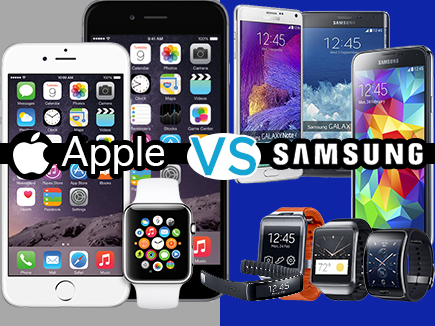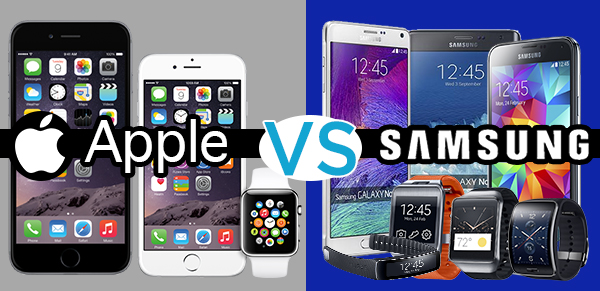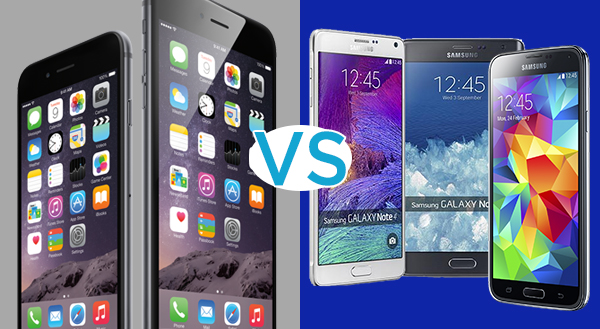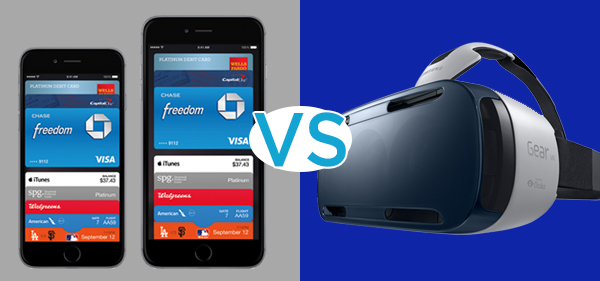Apple vs. Samsung: Who's Winning Now?
The Apple Watch is just the latest volley fired in the battle between the two tech giants. Who is winning the innovation war?


"Hey, we've been making big-screen phones for years!" "Big deal; we're already on our sixth smart watch." These are just some of the things I picture Samsung execs saying aloud as they watched Apple's big event unfold.
Although Apple is dominating the news right now, it's easy to forget that Samsung recently held an event of its own, during which it showcased two new smartphones and a virtual-reality headset. Samsung also has a new smartwatch on the way. It's a good time to take stock and evaluate which company is winning the innovation war.
Smartphones

The iPhone 5s was already the best-selling smartphone. But with the iPhone 6 (4.7 inches) and iPhone 6 Plus (5.5 inches), Apple now has a duo in its lineup that will compete directly against the Samsung Galaxy S5 (5.1 inches) and Galaxy Note 4 (5.7 inches). The Galaxy Note Edge will be a more premium option than the Note 4.
MORE: iPhone 6 Hands-On — The Plus Steals the Show
It's clear that Apple and Samsung are concentrating their efforts in different areas. For the iPhone 6, it's all about the bigger and more beautiful Retina HD displays and better camera. Focus Pixel technology promises much faster autofocus in both photos and videos. I was stunned by how quickly Apple's device changed focus from one subject to another during a clip of kids playing by a pool.
Both iPhone 6 handsets boast more attractive and solid anodized aluminum designs with rounded edges. The Galaxy S5 is all plastic, but it's water-resistant. The Note 4 and Edge have metal frames but soft-touch plastic backs.
Apple deserves credit for doing a better job than Samsung of making it easier to activate one-hand mode. All you need to do on the iPhone 6 is double tap (not press) the home button to put items within easy reach of your thumb. On Samsung phones, you need to activate a setting.
The iPhone 6 Plus isn't just bigger than the iPhone 6; it also does more with its larger display, as several apps work in dual-pane mode. However, the new Galaxy Notes do this, too, and all of the latest Galaxy phones let your run two different apps side by side (not so with the iPhone 5s). Samsung also has the edge on screen resolution across the board.
MORE: Galaxy Note 4 Hands-On — New King of Phablets
The Galaxy Note Edge innovates with a curved secondary Edge display that shows your favorite apps, notifications, sports scores and more. Don't forget that only Samsung's phablets offer pen input, which feels more natural with this generation.
Apple seems to have the edge in the fitness and health department. Although the Galaxy S5 and Note series sport a heart-rate monitor on the back, Apple's devices promise to keep better tabs on your activity via better designed apps, a more accurate M7 motion co-processor and a barometer that can track your stair climbs.
Who's winning? Draw. The iPhone 6 strengthens Apple's smartphones in areas where the company was already beating Samsung, including camera quality, design and mobile payments (see Unique Innovations, below). But Samsung is also pushing the envelope by refining technologies Apple doesn't offer, like pen input, while experimenting with new ones (Edge display).
Smartwatches

The Apple Watch is the smartwatch everyone has been waiting for. And you'll have to wait longer, as the wearable won't hit stores until early next year. However, based on what I know so far, the Apple Watch beats Samsung's latest and greatest in some key areas.
If you assume the Tizen-powered Gear S is Samsung's latest flagship, the Apple Watch runs circles around it in terms of design. Apple's device, made of forged stainless steel, is a thing of beauty. Plus, it's more compact than the Gear S, whose curved design comes in only one size.
MORE: Apple Watch Hands-On — Worth the Hype?
I also like having a combination of a digital crown (dial) and touch screen on the Apple Watch. The Gear S and other Samsung smartwatches rely more on swiping.
The Apple Watch will come in two sizes, to fit those with small and large wrists: one with a 1.5-inch display and another in 1.7 inches. Both watches use sapphire crystal screens for unparalleled scratch resistance. The Galaxy Gear S sports a bigger, 2-inch curved AMOLED display, but it's more unwieldy to both wear and put on your wrist.
While Samsung offers plenty of choice in the smartwatch arena, there's more fragmentation. You have one device running Android Wear (Gear Live), one running a proprietary OS (Gear Fit) and a few running Tizen (Gear Neo, Gear 2 and now the Gear S).
The Apple Watch will come in multiple flavors, but they'll all be running the same OS. There's the Apple Watch (basic model), the Apple Watch Sport (more durable and lighter) and the 18-karat-gold edition.
The Apple Watch is a more social device, too. You can digitally poke another Apple Watch wearer with a tap, and they'll feel a haptic vibration on their wrist wherever they are. You can also draw a quick note, have a quick walkie-talkie conversation or even share your heartbeat.
MORE: Samsung Gear S Hands-On
Samsung's Gear S has some things going for it. With its built-in 3G connection, you'll be able to make calls and get GPS data without needing your smartphone. Apple's Watch pulls ahead in the fitness department, promising more accurate heart-rate monitoring while you move.
What about apps? Samsung says the Gear S will have 1,000 apps at launch, but I expect Apple to surpass Samsung in terms of quality and quantity once developers take advantage of the SDK. For instance, Starwood hotels will let you unlock your hotel room with a tap of your Apple Watch. (No more key cards!)
Who's winning? Apple. Based on early impressions, Apple should take the lead in the smartwatch war. It looks like a more polished experience, and there will be more choice (both in terms of device versions and apps) without confusion.
Unique Innovations

Apple and Samsung are taking two very different big bets on the future. For Samsung, it's about virtual reality. Created in partnership with Oculus VR, the new Gear VR headset promises to re-invent entertainment. During a demo, I was wowed as I got a front-row seat at a Coldplay concert. As I turned, I could see the audience's reaction, which made the experience more immersive. You'll also be able to take virtual tours in a whole new way.
The Gear VR, which will reportedly cost $199, is powered by a Galaxy Note 4 device that snaps into the headset. Its powerful Snapdragon 805 processor will enable a whole new way to play games. I loved the space shooter I tried, taking aim with my eyes as I spun around in my chair while firing with the onboard touchpad. Samsung will also offer an Android-compatible gamepad.
MORE: Gear VR Eyes-On — Virtual Reality Goes Mobile
Apple's potential game-changer is more practical: Apple Pay. Using NFC and a secure element in your iPhone 6, you'll be able to buy items at more than 220,000 stores with just a tap. Macy's, McDonald's, Walgreens and Disney are among the heavy hitters already on board. Apple Pay is also coming to the Apple Watch, which will be even more convenient.
Apple Pay will also extend to the Web through various partners, such as Target. As someone who goes to Panera a lot, I like that I'll be able to pay for items even before I arrive. OpenTable fans will love that they'll be able to pay their bill via Apple Pay right from the app at participating restaurants.
Who's winning? Samsung. Apple Pay could change the way we all shop, but the Gear VR makes me more excited about the future.
Bottom Line
Samsung likes to talk about "relentless innovation," which is a double-edged sword. Following this mantra enabled the company to be first in big-screen phones, and the Galaxy Note 4 and Note Edge up the ante. However, Samsung seems to be moving too quickly in the smartwatch arena with too many options, leaving the door open for Apple's more focused and refined-looking competitor.
Right now I give Apple the overall edge. The Gear VR could literally change the face of entertainment (assuming Samsung and Oculus get enough partners on board), but only Apple has the influence to pull off something like Apple Pay. Despite making strides, Samsung’s ecosystem for partners and developers simply isn’t as strong. Nevertheless, Samsung deserves more credit than it's getting for taking more risks.
- How Much Is Your iPhone 5 / 5s / 5c Worth Now?
- iPhone 6 vs. iPhone 6 Plus vs. Samsung Galaxy S5 vs. Galaxy Note 4
- Best Smartphones 2014
Mark Spoonauer is the editor in chief at Tom's Guide and has been following the Apple-Samsung War since the original iPhone and Samsung Instinct. Follow him at @mspoonauer. Follow Tom's Guide at @tomsguide, on Facebook and on Google+.
Sign up to get the BEST of Tom's Guide direct to your inbox.
Get instant access to breaking news, the hottest reviews, great deals and helpful tips.
Mark Spoonauer is the global editor in chief of Tom's Guide and has covered technology for over 20 years. In addition to overseeing the direction of Tom's Guide, Mark specializes in covering all things mobile, having reviewed dozens of smartphones and other gadgets. He has spoken at key industry events and appears regularly on TV to discuss the latest trends, including Cheddar, Fox Business and other outlets. Mark was previously editor in chief of Laptop Mag, and his work has appeared in Wired, Popular Science and Inc. Follow him on Twitter at @mspoonauer.
-
bipbap Maybe I am being a Samsung fanbio, but it seems the author either uses an actual Apple product to show superiority to Samsung or the fact an Apple product is coming to prove superiority to a Samsung product. It seems it should be more of an Oranges-to-Oranges kind of comparison (pun deliberately avoided).Reply -
coolitic All apple products are mediocre, locked down devices.Reply
I'd like to say any device with similar price to apple devices is better than the apple device, whether it's samsung or not, I will never buy crappy apple products. -
Mark Spoonauer Thanks bipbap. This commentary is indeed based on impressions of some products that are not yet available for sale, including both Samsung and Apple. I've had a chance to go hands-on with all of them.Reply
Of course, execution and how well these products fare with shoppers will be critical, and I anticipate revisiting this topic once full reviews have been conducted across the board. -
kawininjazx You can put a $25 SD card into your 16GB Samsung and have 48GB of storage, winner: SamsungReply -
nuvon ReplyAll apple products are mediocre, locked down devices.
I'd like to say any device with similar price to apple devices is better than the apple device, whether it's samsung or not, I will never buy crappy apple products.
Who cares if you buy Apple product?
Who cares if you buy Samsung product?
No one, other than your stubborn biased mind!
-
bipbap ReplyThanks bipbap. This commentary is indeed based on impressions of some products that are not yet available for sale, including both Samsung and Apple. I've had a chance to go hands-on with all of them.
Of course, execution and how well these products fare with shoppers will be critical, and I anticipate revisiting this topic once full reviews have been conducted across the board.
Hi Mark, I appreciate the response. I know I should have given it a second, more thorough read to make sure I was following correctly, but the one window here in Mom's basement is cloudy, so I was too gloomy to do so :) I still enjoyed the article. -
Innocent_Bystander It comes down to iOS vs. Android.Reply
I'll skip both and stick to my Windows Phone 8.1 Lumia 920. I'm not seeing a compelling enough value proposition from each camp to make me switch platforms. -
bipbap ReplyThanks bipbap. This commentary is indeed based on impressions of some products that are not yet available for sale, including both Samsung and Apple. I've had a chance to go hands-on with all of them.
Of course, execution and how well these products fare with shoppers will be critical, and I anticipate revisiting this topic once full reviews have been conducted across the board.
Thanks Mark for the response. I know I should have read it through a second time to make sure I was following correctly, but the sole window here in Mom's basement is quite dark from the clouds, so I was feeling to gloomy to do so :) I still enjoyed your article.

